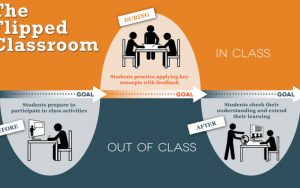By Lindsey Danburg

If you’re looking to implement a more student-centered approach in your classroom in which students spend more time applying knowledge and less time listening to you lecture, then the flipped classroom may be for you.
At the very basic level, a flipped classroom is a pedagogical approach where students watch recorded lectures, online videos, and take online assessments on the materials prior to coming to class. Class time is used to practice skills and promote deeper learning using case studies, discussions and other in-class activities that require collaboration and problem-solving.
Although, there may be a larger amount of work done upfront to make a flipped classroom work, including recording lectures, creating online assessments and finding appropriate evaluations, case studies and examples to use in class, the benefits of flipped classrooms are tremendous. Flipped classroom techniques improve student metacognition and create an environment conducive to collaborative learning (Brame, 2013). This can impact both instructor and student satisfaction with course material, leading to a more positive classroom experience and deeper understanding of material covered in the course (Wong, 2012).
There are numerous benefits, both to students and instructors.
Benefits for students:
- Students can access the lecture/video material at their pace on their schedule and go through material as quickly or slowly as they desire. Students can pause, replay, or speed up material as needed allowing for greater depth of material understanding (Wong, 2012). This may be especially helpful for international students or non-native English speakers.
- Assessments on materials allows students to gauge their own understanding of materials and allows them to see what items need more of their focus (Brame, 2013).
- If students miss a class, they can catch up more quickly and easily then if they had missed an in-class lecture and instructors will not have to attempt to recreate lecture material to get student caught up (Mihai, 2016).
- Once the lectures have been recorded you can use many times as you would like. This is especially helpful if you are teaching multiple sections of a course, or teaching the course every semester (Mihai, 2016).
- Class time is used to support students and improve their critical thinking skills. Instead of lecturing during class time, your time is freed up to engage students in other ways and increase meaningful class participation (Mihai, 2016).
- Flipped classrooms provide you with the ability to test your student learning comprehension after materials have been presented. This can been done in a variety of ways including quizzes, discussion boards, or short writing assignments. Prior to class you can review these to assess student understanding and to answer questions about material during class time (Brame, 2013).
Where to learn more about flipped classrooms at UConn?
CETL also offers a teaching seminar called Introduction to Flipped Courses. Check their website http://cetl.uconn.edu/seminars/ for upcoming seminar dates.
References:
Brame, C. (2013). Flipping the classroom. Vanderbilt University Center for Teaching. http://cft.vanderbilt.edu/guides-sub-pages/flipping-the-classroom/.
Mihai, L. (2016). 8 Flipped Classroom Benefits For Students And Teachers. Retrieved from: https://elearningindustry.com/8-flipped-classroom-benefits-students-teachers
Wong. W., (2012) Why Flipped Classrooms Work for Students. EdTech Magazine. Retrieved from: http://www.edtechmagazine.com/higher/article/2012/08/why-flipped-classrooms-work-students
